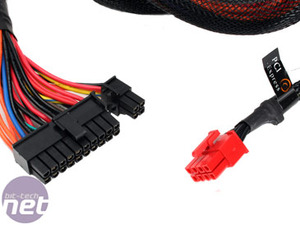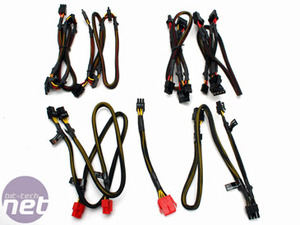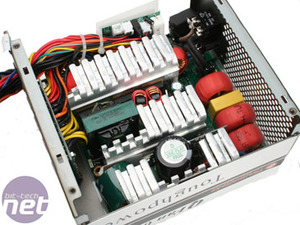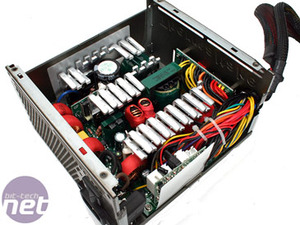
Supplied Cables
- One 55cm 20+4-pin black braided ATX cable
- One 55cm 8-pin black braided PCI-Express cable with 20cm 8-to-6-pin adapter
- One 12V black braided power cable with 8pin and 4pin connectors at 45cm and 60cm
- Two 55cm 6-pin black braided PCI-Express cables
- Two black braided SATA power cables with three connectors at 45cm, 60cm and 75cm
- One black braided cable with three Molex connectors at 45cm, 60cm, 75cm and one floppy connector at 90cm
- One black braided cable with four Molex connectors at 45cm, 60cm, 75cm, 90cm and one floppy connector at 105cm
The provided connectors are plentiful—especially for Molex and SATA—and we like the option for the 20+4pin ATX connector which provides inline legacy support. All the connectors are black and the Molex connectors even include extra plastic push-release bits so you can easily get the plugs out.

Having three PCI-Express cables is a little weird though, but it does provide a niche support for three-way CrossFireX or one HD 3870 X2 and a single card, for example. Only one of these is an 8-pin connector though which is quite disappointing, and instead of it being a 6+2-pin for convenience and tidiness it’s an adapter cable that adds an extra 20cm of cable instead. We feel it’s unnecessary considering the alternative and the extra connection can potentially introduce a voltage drop.
In addition to this the 12V CPU power cable comes with a solid 8-pin connector that has a 4-pin sprouting out from it in an untidy manner. Again, why not just a simple 4+4-pin connector that offers the same choice?
At the other end, the PSU differentiates between the connectors cleverly and simply by colour and size – it’s easy to spot that the PCI-Express connectors go in the red 6-pin sockets, the 12V in the 8-pin and the peripheral connectors in the other four 6-pin sockets.
What’s Inside?
Please remember that this not only voids your five year warranty, but it's also significantly more dangerous than just playing around inside a PC when it's on – you have the full power of a wall socket at your fingertips, and not just 12V!The usual four screws in the top are easily removed along with the top casing allowing access to the fan. Inside the same plastic cover is simply screwed on to the case of the QFan, just like it was with the Corsair TX750W PSU – unscrewing this allows the fan to breathe a little easier, but it also means the air feels like it’s flooding straight out the back too.
There are three sets of quite large, aluminium heatsinks on a single PCB and while the available space has been put to more use than it was in the Corsair, that’s only because of the extra modular plug sockets.

MSI MPG Velox 100R Chassis Review
October 14 2021 | 15:04












Want to comment? Please log in.